Table of Contents
The pomegranate Bonsai is a deciduous tree characterized by its trumpet-shaped, red flowers, narrow oblong leaves, thick trunks, big round red fruits, and are known to be fitted into all kinds of boxes. The plant is native to some parts of the Middle East and India, but can also be found in other places around the world through the silk road.
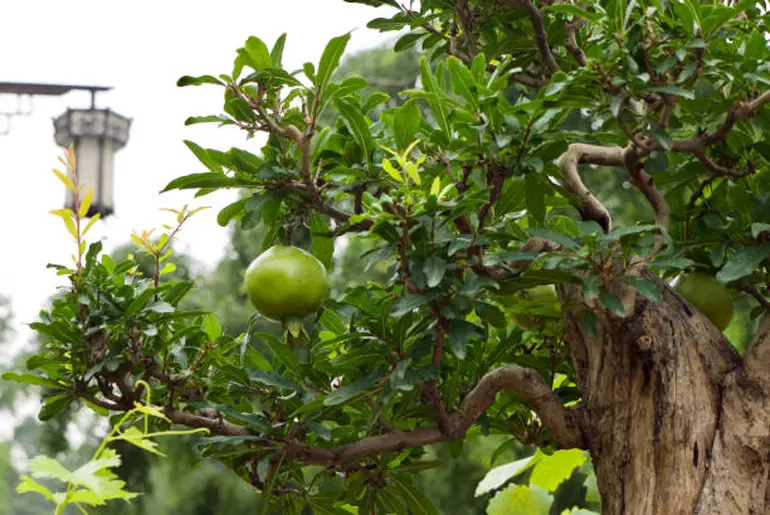
The pomegranate plant is popular among Bonsai growers for its misshapen appearance and its hardiness. They are easy to grow and maintain under the appropriate climate and have remarkable resistance to pests and diseases. Read this article for all you need to know about how best you use a pomegranate plant for Bonsai specimen as well as other closely related issues.
| Scientific Name | Punica Granatum |
| Family | Lythraceae |
| Average Height | 6 to 20 feet |
| Average Spread | 4 to 15 feet |
| Origin Countries | Middle and western Asia |
| Type | Deciduous shrub |
| Flower Bloom Time | July to August |
| Water | Dry |
| Sunlight | Full sun |
| Maintenance | Medium |
Can you Bonsai Pomegranate tree?
Yes, you can Bonsai a Pomegranate tree. The pomegranate tree is one plant that will germinate fast when grown under the right conditions, hence they can make an excellent Bonsai specimen. Plus the tree has bears edible fruits that are nonpoisonous to both humans and pets, so if you are a lover of fruits, you can easily grow one indoors.
However, because pomegranate is a fruity plant, it is best to grow them in a medium to large style if grown as a Bonsai specimen. Also, you should know that when you are making use of the Dwarf pomegranate variant as your specimen, it is recommended that you don’t wire them must be styled by clip and grow.
Pomegranate Bonsai History
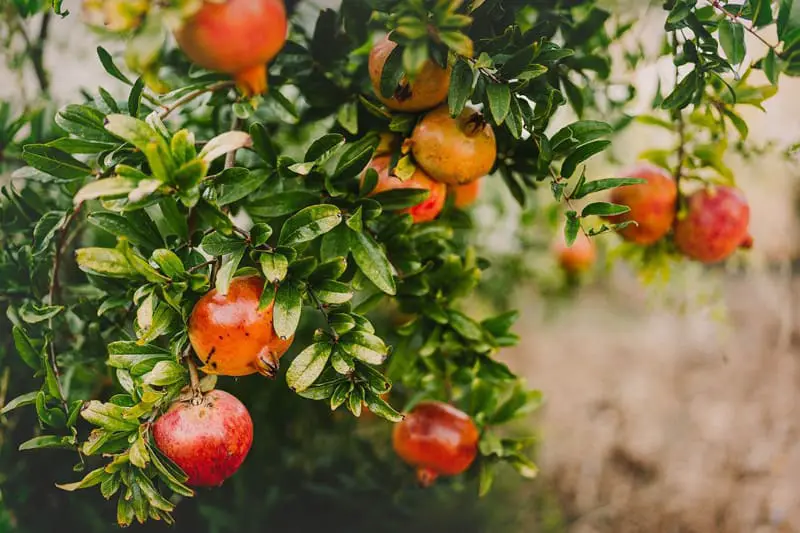
According to historians, the pomegranate tree has been widely cultivated in Persia and Central India for about 4000 years. After some years, pomegranate cultivation became a hobby for people around the Mediterranean coast, as well as the people of Asia Minor before the plant was taken to Northern America by the Spanish settlers.
Nowadays, pomegranate cultivation is now very popular in India and drier parts of Asia, East Indies, Tropica Africa, and Malaya. However, in most of the cities in those regions mentioned earlier, they are not grown in commercial quantities as it is being done in cities like; China, Saudi Arabia, Burma, Iraq, Iran, Afghanistan, Egypt, Bangladesh, India, and Pakistan.
Pomegranate Bonsai scientific name
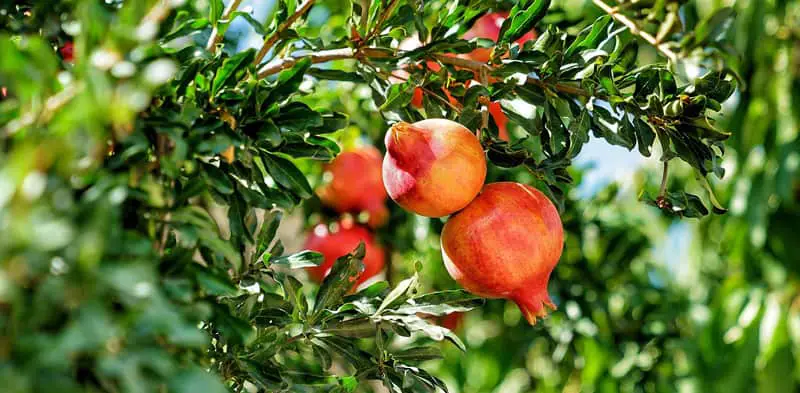
The scientific name of Pomegranate is Punica granatum
Pomegranate Bonsai care
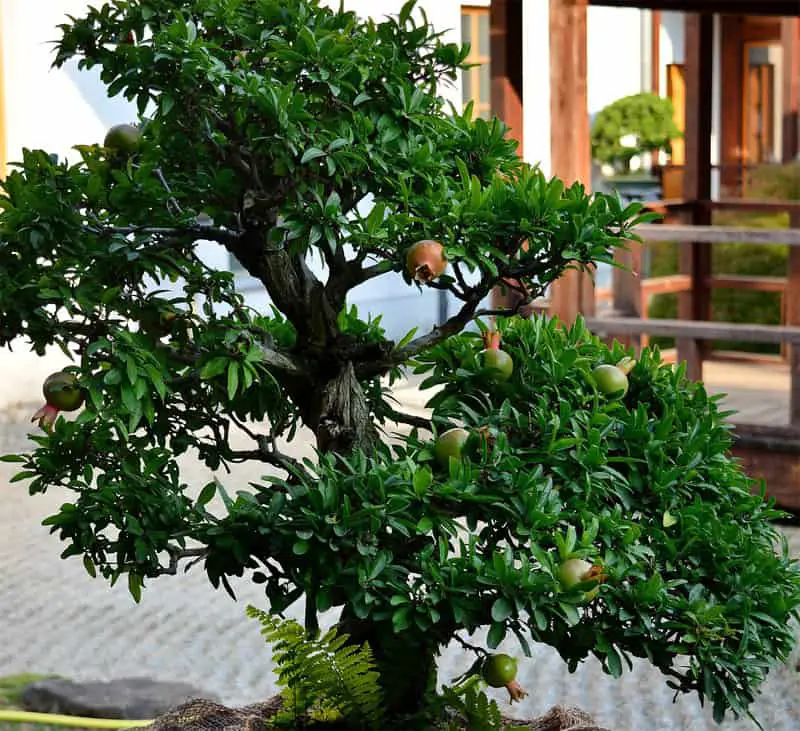
The Pomegranate tree is a fast grower that is very easy to grow, but if not given the proper care or attention, you may not enjoy those amazing qualities. Check the details below for information on how best to cultivate a pomegranate tree to your desired style.
Pomegranate Bonsai temperature
It is best to raise a Pomegranate in warm, sunny areas, however, during their dormant period (winter), it is ideal you shade them away from direct sunlight. The standard temperature under which a Pomegranate should be raised is any level of temperature above 41°F.
Although they can withstand cold to a certain extent, when they are left unprotected, they may exhibit stunted growth: a deformity not desired by any Bonsai grower. During winter, place your Pomegranate Bonsai in a place with frost-free cold with a temperature level of 35° to 46°F.
Pomegranate Bonsai Fertilizer
You can either feed your Pomegranate tree with multi-purpose fertilizer made especially for Bonsai plants (note: must be applied at half the strength of the fertilizer) you can make use of fertilizers formulated specifically for pomegranate plants.
When to fertilize Pomegranate Bonsai
Application of fertilizers to a pomegranate tree is a bit tricky as application varies based on seasons and treatment. Check below for information on how best to apply fertilizer between seasons.
1. Growing seasons
Just like every other fruity and flowery plant, Pomegranate requires more fertilizer during its growing season than every other season. You can make use of either liquid or gentle fertilizers. Your plant should be fed with any of these fertilizers every two weeks during this period. However, you should not apply fertilizer when the plant starts to bloom.
2. Winter season
Pomegranate plants reach dormancy during the winter months, and as a result, during this period, it usually becomes difficult for Pomegranate plants to make use of fertilizers to stimulate new growth. Therefore fertilizer application should be paused during this season until springtime is close enough.
Post repotting
Like every other Bonsai tree, when you repot a pomegranate tree, its root will become stressed; consequently, this will cause a change to your fertilizer application routine in that specific year when you repot your tree. Fertilizer application should be delayed till 3 months after reporting to give your tree enough recovery time.
Pomegranate Bonsai Trimming and Pruning
Every Bonsai tree needs to be pruned regularly to stay in shape, but when it is done the proper way, or you prune your tree at the wrong time, it will affect the growth of your tree. Check below for information on how to prune your Pomegranate Bonsai tree in the best possible way.
Pomegranate pruning and trimming
When trimming a Pomegranate tree, new shoots should be pinched back to 1 to 3 leaves with your hand instead of using shears or clippers. Leave the branches of your pomegranate tree to grow beyond the initial growth you intend for them to encourage new growth, prune thereafter.
If you desire for your Pomegranate tree to bear fruits and blossom flowers, delay your pruning till when your tree passes its blooming stage.
Pomegranate Bonsai Wiring
When wiring larger Pomegranate species, wire the tree branches with aluminum or thin copper wire. However, while you are at it, make sure you are careful enough not to wrap too tightly or go overboard with your bending. Doing so may lead to brittle branches. When dealing with a Dwarf Pomegranate tree, shape the tree using the clip and grow technique so that your tree doesn’t suffer from dieback.
Pomegranate Bonsai repotting
Repotting is one of the best care you can give to your Pomegranate tree. This is because repotting will prevent your tree from becoming root-bound. Although Pomegranate Bonsai trees benefit from becoming slightly pot bound, if the growth is not curtailed, it will impact negatively on your tree. Check below for information about Pomegranate repotting.
When to repot Pomegranate Bonsai
A pomegranate Bonsai tree is best reported every 3 – 4 years because they bloom massively when their root systems have not become pot-bound. Repotting of a Pomegranate Bonsai tree should be done towards the end of winter. They can also be repotted during spring, but make sure it is done before new buds start to develop.
Young Pomegranate Bonsai should be repotted annually or every 2 years. Similarly, your older Pomegranate should be biennially repotted or every 3 years or anytime you notice that the root of your tree is outgrowing the soil.
Another important factor to consider when repotting a Pomegranate tree is the type of pot to use. Do not use a shallow pot because a Pomegranate tree will flower best when it becomes slightly root-bound. You can prune about 1/3 of the entire root balls, but only half part of the fine roots should be pruned. Then you can transplant your plant into a Fujiyama soil mix as it is considered to be one of the best draining soil for a Pomegranate tree.
Pomegranate Bonsai pets and diseases
During wet seasons, Pomegranate trees are usually vulnerable to Mold infestation. To control the spread of mold all through the plant system, treat infestations with fungicides.
Also, Pomegranate trees are commonly attacked by whiteflies, Aphids, and Pomegranate butterfly caterpillars. The Whitefly infection is a problem commonly encountered indoor Bonsai growers. Whitefly diseases can be readily controlled by spraying the affected tree with water. For effective use, spray directly under the tree leaves.
To prevent your tree from being attacked by stubborn whiteflies at all, make sure to raise your Pomegranate tree in a well-ventilated area. You can also get rid of Aphids on your bonsai by rinsing them off with a jet of water.
Non-toxic insecticides should be applied every few months to help disinfect your Pomegranate Bonsai against any kind of pests. Also, it is recommended that you inspect your Pomegranate plant regularly to check for early signs of infections because the earlier the treatment, the better.
Warning!!!
It is not advisable to spray insecticides of any kind on your Pomegranate tree anytime the soil is dry.
Bonus: Pomegranate trees as well as other Bonsai trees are vulnerable to infections, however, good ventilation, adequate use of fertilizers, watering, and timely repotting will save you from having to deal with any infection at all.
Pomegranate Bonsai soil
The pomegranate tree is native to places where alluvial soil is commonly seen: therefore, their potting mix must contain well-draining soil that is comprised mostly of decomposed granite. For a Pomegranate to produce flowers, fruits, and broad leaves, they must be fed with organic nutrients. Plant your Pomegranate Bonsai in a soil mix comprising 60% aggregate and 40% organic.
Pomegranate Bonsai watering
Even though Pomegranate trees have edible fruits, beautiful flowers, and broad leaves, they don’t require excess water to spur those qualities; they only require a moderate amount of water. When you overwater a Pomegranate plant, it will suffer from root rot. Also, always keep the soil moist and never should let the compost soil dry up. You can monitor the moisture level of your plant by making use of a moisture meter. Water the plant at least once a week.
Pomegranate Bonsai Sunlight
During summer, keep your Pomegranate Bonsai outdoors under full sun and if they are to be grown inside, make sure they are positioned by a sunny window or you can make use of artificial light for bonsai. Just make sure they receive a considerable amount of light a day. During winter, they can be exposed to lesser sunlight.
Pomegranate Bonsai types
There are several varieties of the Pomegranate Bonsai trees which each has a distinctive trait distinguishing it from other variants. While done bear sweet fruits the fruits of some are sour: check below for brief information on the different types of Pomegranate Bonsai tree.
Twisted Pomegranate Bonsai
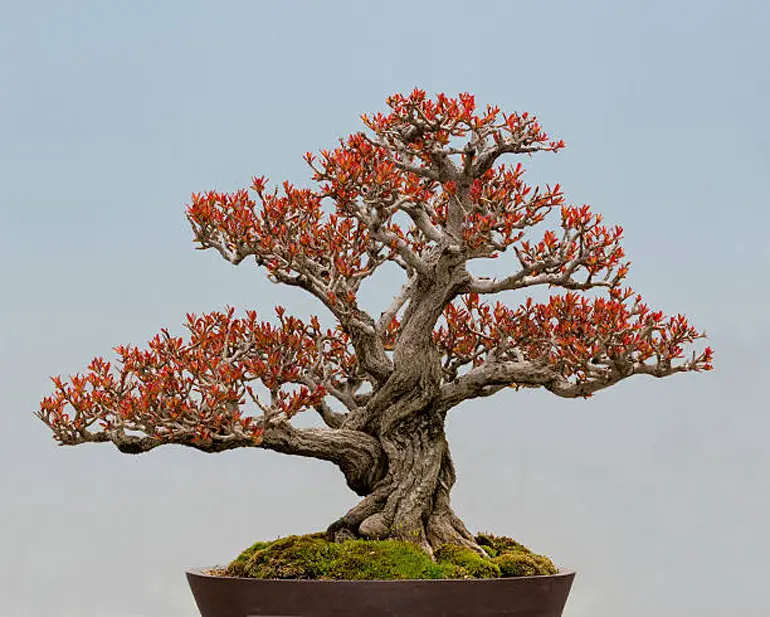
The Twisted Pomegranate is a shrubby plant characterized by its display of orange-red single flowers during summer. It bears edible fruits and can grow as tall as 10 to 15ft.
Dwarf Pomegranate Bonsai
Dwarf Pomegranate Bonsai is an excellent tree choice for growers who do not want to experiment with a massive tree. The tree is usually small, suitable to be grown in a container, and requires a minimal amount of soil to grow. Dwarf Pomegranate is characterized by its beautiful red flowers and its tasteful edible fruits.
Russian Pomegranate Bonsai
The Russian Pomegranate is one of the sweetest varieties of the Pomegranate family. It can grow up to 304 cm tall with a width of about 3m if grown in the wild. However, when trained indoors as a Bonsai or houseplant, it can be pruned to the standard Pomegranate Bonsai style and size.
One interesting fact about this particular species is that they can pollinate by themselves and produce Pomegranate. They are cold hardy and can withstand hot weather
Utah sweet Pomegranate Bonsai
The Utah Pomegranate tree just like its name sounds bears sweet fruits. It is also self-pollinating but ends to producing more fruit when cross-pollinated with other trees. It can grow up to 20 to 30 feet when growing in the wild, but when grown indoors as a houseplant or Bonsai, it can be pruned to standard size.
Pomegranate Bonsai winter care
Although Pomegranates are cold-hardy to some extent, but cannot tolerate frost for long, and therefore, they must be protected against frost-cold. The best way to protect your Pomegranate during winter is by creating a frost-free cold environment for them by placing them in a place with a temperature level between 35 to 46°F.
Pomegranate Bonsai seed germination
It takes a Pomegranate seed about 3 to 4 weeks to germinate when raised under a standard temperature level of 20 – 22°c. After germinating, make sure your Pomegranate seedlings are slightly damp every time. Then place where it can get enough light, but must be protected from being exposed to low humidity and frost. Do not use a shallow pot for your Pomegranate seed.
Can we keep Pomegranate Bonsai tree small?
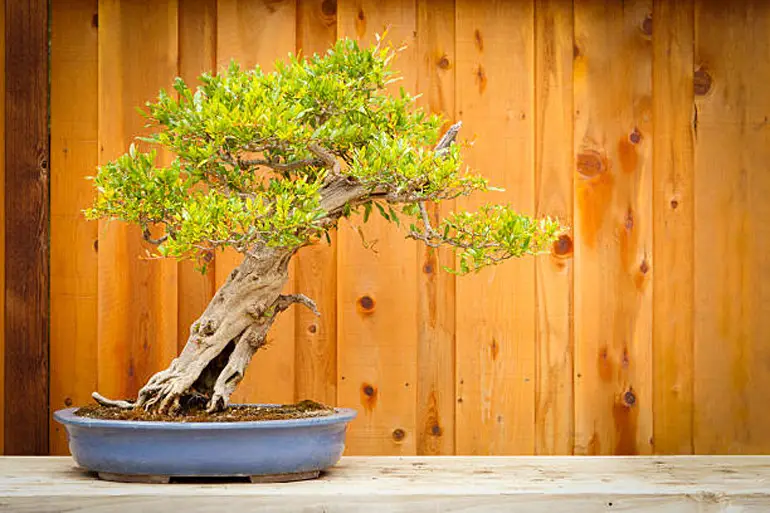
Yes, you can keep a Pomegranate Bonsai tree small. Pomegranate trees are notorious for their vigorous roots. No matter how you try to keep their root small, they will still become root-bound. The best way to keep their growth small is by pruning about 1/3 of their root balls every time you repot and also by pruning about 50% parts of their fine roots.
Can we grow Pomegranate Bonsai trees indoors?
Yes, you can keep a Pomegranate Bonsai indoors. Although Pomegranates are best grown outdoors because they love sunny climates, however, they can also be successfully grown indoors as long as they are placed in a place where they can be exposed to adequate sunlight daily.
Do Dwarf Pomegranate Bonsai trees produce fruit?
Yes, Dwarf Pomegranates produce fruits but their fruits are usually small compared to the ones produced by other Pomegranate varieties.
How to start a Pomegranate Bonsai
You can start a Pomegranate tree cultivation by using the tree’s seed and cuttings, or air layering. The best time to make your hardwood cuttings is during the spring before the buds start to open up; while the semi-hardwood cuttings should be made during summer. You can also make use of root cuttings.
How to grow a Pomegranate Bonsai tree from seed
It is very easy to cultivate a Pomegranate tree Bonsai from seed. Check the following steps for details on how to grow a Pomegranate seed from seed.
- Wash the seeds with water.
- Get rid of all pulpy coats on the seed by using a paper towel to rub them off the body of the seed.
- Leave the seed to dry for several days.
- After the seed becomes completely dry, plant it in a seed starting soil.
- Cover the seed with plastic to facilitate humidity.
- Wet the soil and keep it moisturized afterward until the seed starts to germinate.
How to grow a Pomegranate Bonsai from cuttings
Compared to planting from seed, growing a Pomegranate from cuttings is a bit complicated. Follow the steps below for information on how best to grow a Pomegranate Bonsai tree from cuttings.
- Dip the Pomegranate cuttings in a growth hormone almost immediately after the cuttings were taken. (Note; It is the end of the cuttings that must go into the soil)
- Keep the cuttings in your greenhouse to develop before planting.
- Plant the cuttings in a well-draining soil mix you already prepared in a pot.
- Cover the pot with a plastic bag to give room for humidity.
- Keep the pot in a shady, but warm place where your new plant will not be exposed to high and direct sunlight.
- Open the pot every 10 days to water the soil. You can also mist the stems.
Bonus: Each of the cuttings taken must be at least 25cm long and must be taken from a Pomegranate tree of about 1-year-old wood that is 1.27cm in diameter.
![Pittosporum Bonsai [Pittosporum Tobira]](https://www.bonsai-express.com/wp-content/uploads/2022/05/Pittosporum-Bonsai-365x200.jpg)
![Sorbus Bonsai [Sorbus Aucuparia]](https://www.bonsai-express.com/wp-content/uploads/2022/05/Sorbus-Bonsai-365x200.jpg)
![Tsuga Bonsai [Tsuga Canadensis]](https://www.bonsai-express.com/wp-content/uploads/2022/05/Tsuga-Bonsai-365x200.jpg)
![Tamarix Bonsai [Tamarix Ramosissima]](https://www.bonsai-express.com/wp-content/uploads/2022/05/Tamarix-Bonsai-365x200.jpg)